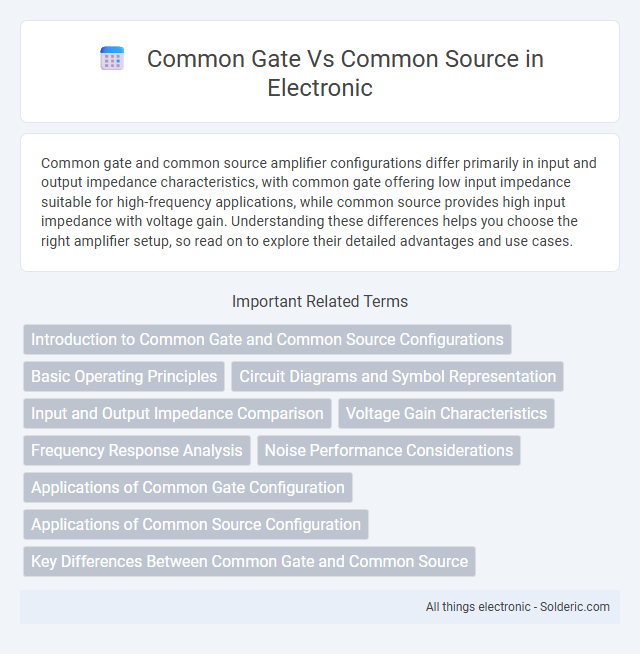Common gate and common source amplifier configurations differ primarily in input and output impedance characteristics, with common gate offering low input impedance suitable for high-frequency applications, while common source provides high input impedance with voltage gain. Understanding these differences helps you choose the right amplifier setup, so read on to explore their detailed advantages and use cases.
Comparison Table
| Aspect | Common Gate (CG) | Common Source (CS) |
|---|---|---|
| Configuration | Gate terminal is common to input and output | Source terminal is common to input and output |
| Input | Signal applied to source terminal | Signal applied to gate terminal |
| Output | Output taken from drain terminal | Output taken from drain terminal |
| Input Impedance | Low (typically 50-300 O) | High (typically 1 kO or more) |
| Voltage Gain | Less than 1 or close to 1 | Greater than 1 (can be high) |
| Phase Shift | 0deg (no inversion) | 180deg (inverting) |
| Frequency Response | Better high-frequency response | Limited by Miller effect at high frequencies |
| Applications | Impedance matching, wide bandwidth amplifiers | Voltage amplification, general-purpose amplifier |
Introduction to Common Gate and Common Source Configurations
Common Gate and Common Source configurations are fundamental transistor amplifier topologies used in analog circuit design. The Common Gate configuration has the gate terminal grounded and is known for providing low input impedance and high output impedance, making it suitable for high-frequency applications. The Common Source configuration connects the source terminal to ground, offering high voltage gain and moderate input impedance, often used in voltage amplification stages where gain is a priority.
Basic Operating Principles
Common gate amplifiers operate by fixing the gate voltage and inputting the signal at the source, enabling high-frequency response due to low input capacitance. Common source amplifiers input the signal at the gate with the source grounded, providing high voltage gain and wide bandwidth. Understanding these basic operating principles helps optimize your circuit design for specific amplification needs.
Circuit Diagrams and Symbol Representation
Common gate and common source configurations differ notably in their circuit diagrams and symbol representation. The common gate circuit features the gate terminal connected to a fixed voltage (ground or bias), with input applied to the source and output taken from the drain, visually distinguished by the gate terminal being grounded in the symbol. In contrast, the common source setup shows the source terminal grounded, input at the gate, output at the drain, and the symbol reflects the gate as the input node with the source tied to ground, providing clarity on signal flow direction for your circuit design.
Input and Output Impedance Comparison
Common gate amplifiers exhibit low input impedance typically ranging from a few ohms to tens of ohms, making them suitable for high-frequency input signals and low-impedance sources. In contrast, common source amplifiers possess high input impedance often in the megaohms range due to the gate terminal's capacitive nature, ideal for voltage amplification from high-impedance sources. Output impedance in common gate configurations is generally moderate to high, influenced by the transistor's drain resistance, whereas common source amplifiers often feature higher output impedance, impacting the load driving capability and frequency response.
Voltage Gain Characteristics
Common gate amplifiers exhibit low input impedance and typically provide voltage gain close to unity, making them ideal for high-frequency applications where stable gain is crucial. Common source amplifiers deliver higher voltage gain compared to common gate configurations, due to their higher input impedance and greater transconductance. Your choice between these topologies depends on the trade-off between gain and input/output impedance requirements in your circuit design.
Frequency Response Analysis
Common gate (CG) amplifiers exhibit superior high-frequency response due to minimal Miller effect capacitance, making them ideal for RF applications. Common source (CS) amplifiers offer higher voltage gain but suffer from reduced bandwidth because the Miller capacitance significantly limits their frequency response. The inherent input capacitance of CG stages results in lower input impedance, enhancing stability and frequency performance compared to CS stages in high-frequency circuits.
Noise Performance Considerations
Common gate amplifiers exhibit lower input-referred noise due to their low input impedance, making them ideal for high-frequency, low-noise applications in RF front ends. Common source amplifiers typically have higher input impedance but generate more flicker noise and thermal noise, impacting sensitivity in low-noise design scenarios. Noise performance must be balanced with gain and impedance requirements when choosing between common gate and common source configurations for specific analog circuits.
Applications of Common Gate Configuration
The common gate configuration excels in high-frequency applications such as RF amplifiers and impedance matching circuits due to its low input capacitance and wide bandwidth. It is ideal for source follower stages where stable input impedance and fast response are required. Your designs benefit from improved noise performance and better isolation compared to common source configurations in these scenarios.
Applications of Common Source Configuration
Common source configuration is widely used in amplification circuits due to its high voltage gain and moderate input impedance, making it ideal for audio and RF amplifiers. It serves as a fundamental building block in analog signal processing and instrumentation systems where signal inversion and amplification are required. Common source amplifiers are preferred in low-frequency applications and provide significant gain without complex biasing arrangements.
Key Differences Between Common Gate and Common Source
Common gate and common source amplifiers differ primarily in their input and output configurations; a common gate amplifier has its gate terminal grounded, providing low input impedance and high output impedance, making it ideal for high-frequency applications. Common source amplifiers have the source terminal grounded, resulting in high input impedance and moderate output impedance, suitable for voltage amplification with high gain. The voltage gain in common source amplifiers is typically higher than in common gate amplifiers, while common gate amplifiers excel in wide bandwidth performance due to their reduced Miller effect.
Common gate vs Common source Infographic

 solderic.com
solderic.com